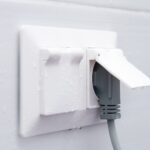Water damage can silently wreak havoc on your bathroom floor beneath your toilet, often leaving you unaware until it’s too late. The culprit? A worn-out toilet wax ring. In this article, not only will you learn how to tackle this essential maintenance task effectively, but you’ll also understand why replacing a toilet wax ring is crucial for the longevity of your bathroom floor.
- Discover a detailed process that ensures your toilet setup remains leak-free and prevents expensive floor repairs.
- Identify the essential tools and materials needed to make the replacement process smooth and efficient.
- Avoid common pitfalls and mistakes commonly encountered when replacing a toilet wax ring, saving you time and frustration.
By the end of this article, you’ll feel equipped to maintain your bathroom’s integrity and save yourself from future headaches. Dive into the details and empower your DIY skills, ensuring a durable and reliable toilet installation.
Step-by-Step Guide to Replace a Toilet Wax Ring: Prevent Floor Damage from Hidden Leaks
Replacing a toilet wax ring is a critical task that, when done correctly, helps prevent leaks and protects your bathroom floor from potential water damage. Start by turning off the water supply to the toilet, and then flush to drain the tank and bowl completely. Disconnect the water line to prepare for removing the toilet from its base.
Next, remove the bolts that secure the toilet to the floor. Carefully lift the toilet and place it on a padded surface to prevent any damage to the porcelain. At this point, you’ll likely see the old wax ring attached to the flange. Use a putty knife to scrape off the old wax ring completely, and inspect the flange for any visible cracks or damage.
Position the new wax ring over the flange. Ensure it is centered correctly to achieve a proper seal, which is essential for preventing hidden leaks. Carefully reposition the toilet over the wax ring, aligning it with the bolt holes. Gently press down on the toilet to secure the wax ring.
Reattach the nuts and bolts, tightening them gradually to avoid cracking the porcelain base. Reconnect the water line and turn on the water supply. Allow the tank to refill and flush the toilet to test for leaks around the base. If no leaks are detected, your toilet installation is successful.
Essential Tools and Materials Needed
Before starting the replacement of the toilet wax ring, gather the essential tools and materials to ensure a smooth and efficient process. You will need a new wax ring, which is the most critical component of this task. Choose a wax ring that fits your specific toilet model for optimal results.
A wrench will be necessary to remove the bolts that secure the toilet to the floor. A putty knife is essential for removing the old wax ring and helps in prepping the area for installation. Additionally, have a bucket and towel ready for any water spills when disconnecting the toilet’s water line.
A level might come in handy to ensure that the toilet is evenly reinstalled to prevent future issues. Depending on your setup, supply line extensions or additional bolts might also be needed, especially if your current components show signs of wear or damage.
Gather these tools and materials before beginning the project to maintain efficiency and reduce the likelihood of interruptions during the replacement process.
Common Mistakes to Avoid When Replacing a Toilet Wax Ring: Prevent Floor Damage from Hidden Leaks
Replacing a toilet wax ring is a delicate task that requires precision and care. Overlooking common mistakes can lead to hidden leaks and potentially severe floor damage. By understanding these pitfalls, you can ensure a successful replacement and maximize the longevity of your bathroom fixtures.
Incorrect Wax Ring Size: Choosing the wrong size is a frequent mistake. Wax rings come in various sizes to accommodate different flange heights. Selecting an incorrect size can prevent a proper seal, leading to leaks. Always measure the toilet flange and confirm the size before purchasing.
Uneven Installation: An uneven wax ring installation occurs when the toilet is not aligned correctly over the flange. This can cause gaps that allow water to seep through. To avoid this, gently lower the toilet onto the wax ring without twisting or rocking it. This ensures an even seal.
Reusing Old Wax Rings: Some might be tempted to reuse an old wax ring for convenience or to save costs. This is a major misstep because wax degrades over time and loses its sealing capability. Always use a new wax ring to ensure reliability and prevent leaks.
Not Tightening Bolts Properly: Either overtightening or under-tightening the bolts that secure the toilet can cause issues. Overtightening can crack the toilet base, while under-tightening may result in an insecure fit and subsequent leaks. Ensure the bolts are snug but not overly tight.
Ignoring Flange Condition: Before installing a new wax ring, inspect the condition of the flange. If it is damaged or corroded, it will not adequately support the seal. Repair or replace the flange as necessary to prevent future leaks.
Frequently Asked Questions on Replacing a Toilet Wax Ring
How often should a toilet wax ring be replaced?
A toilet wax ring typically lasts about 20-30 years, but it should be replaced immediately if you notice leaks or toilet wobble.
What are the signs that a toilet wax ring needs replacement?
Common signs include water leaks around the base of the toilet, a foul odor, and toilet instability.
Can I reuse a toilet wax ring?
No, a wax ring cannot be reused once it has been compressed. Always install a new one.
Do I need to use a wax ring with a flange?
Using a wax ring with a flange can provide additional support and help ensure a better seal.
What tools do I need to replace a toilet wax ring?
- Wrench
- Putty knife
- New wax ring
- Towels
- Your preferred cleaning supplies
Is a wax ring suitable for all floor types?
Wax rings are versatile and can be used with most flooring types but consult a specialist if you have concerns.





